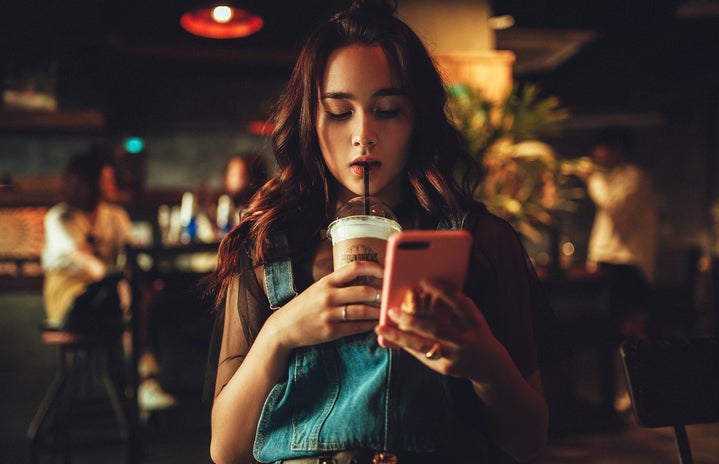A couple of years ago, I decided to dedicate an old Instagram account to lifestyle, food, and wellness. I had always loved posting little moments of my life on social media, but I began to feel self-conscious and unsure of who really cared about these details of my life. I deleted all of my story highlights from my personal instagram account, removed the Snapchat stories I had created for food pictures, and finally decided to dedicate an entire Instagram profile to this content that I never found a comfortable home for.
The first thing I did was follow as many lifestyle, food, and wellness accounts as I could: nutrition students who posted new recipes, holistic health gurus, restaurants from home that I loved, foodies living in large cities… I wanted to curate a personalized feed for myself that was representative of the community I wished to become a part of as my account grew. I noticed that some of the larger wellness influencers, who I now know are typically called “wellness girlies”, were actually friends with each other in real life, meeting up to grab food and post content together. After exploring some inspiration, I decided to make my account public and begin my quest towards becoming a micro-influencer, keeping in mind that I needed between 1,000 and 100,000 followers to technically attain the title.
During the first few months of my account’s creation, I focused on posting coffee shop and restaurant reviews. I quickly realized that if I added some appropriate hashtags, included the location, and tagged the spot’s account, my posts could reach a plethora of new audiences and Instagram spheres. For example, on my first trip to Florida since creating the new account, I photographed and reviewed each food spot I went to, making sure to find their account and tag them before posting. When the restaurants’ accounts became notified of my post, they reposted my content to either their story or their main feed. My follower count began to increase with each of these posts.
Once I returned to my college campus and was no longer able to explore Florida’s food spots, I realized that my content would need an adjustment. I continued to post about any off-campus meals or aesthetic outings, but I chose to slow down on my content as I focused on schoolwork and my life back at Denison. However, each trip out of town allowed me to bring an influx of the destination and food posts that I loved to create. I took as many photos as I could in Connecticut for Thanksgiving and then Florida for Christmas. I made sure to plan content for the coming weeks, even after I left these vacation spots, which were helpful when I returned home. Many of the lifestyle and wellness accounts that I followed in months previous began to follow me back, and some even messaged me with a request to “connect”. I later found out that there are some unspoken “rules” within this social media space that symbolize mutual respect and support between accounts. Here’s what I learned:
- If an account randomly bombards you with countless likes and comments on your account, then you should reciprocate their support by giving a similar, if not the same, amount of engagement on their account. If you do, they’ll most likely give your account a follow, and you should do the same.
- If an account comments a question on one of your posts, then you should probably show the same amount of interest in their account by asking a question of your own on one of their posts. Of course, you should also respond to their question on your post and like their response to your question on their post by clicking on the heart beside the comment.
- If an account randomly gives you a compliment on one or more of your posts, you should respond with a friendly and appreciative comment. They are most likely expecting you to visit their account and do the same.
- If you notice that an account likes a lot of your stories by clicking on the heart at the bottom of each story frame, then you should engage with their stories as well to reciprocate the support.
Throughout the many months that followed, I was able to find a balance between my online content and my authentic, real life experiences. I took a lot of photos and videos throughout my days, but I only dedicated a short amount of time each night to post a few creations, interact with other accounts, and answer a few direct messages. The elements of my micro-influencer journey that I was not prepared for were the incessant messages from scam accounts, fake businesses, phony company recruiters, creepy old men, and potential hackers. Unfortunately, since I wanted to work with companies and be able to create sponsored content, I had to comb through my messages to delete and block these accounts that overwhelmed my inbox. Two years after beginning this journey, I currently have around 200 accounts blocked. As my account grew, I received a steady increase in the number of these unwanted messages. However, I have continued to pick out the reliable requests and have since been able to work with three small product companies. This process consisted of answering their messages, giving them my address to receive the products or getting a gift-card code to obtain the products myself, creating content with the products, and posting this content to my account. I haven’t received any financial compensation yet, just free products, but these partnership posts have been exciting nonetheless!
My account has continued to experience steady growth, but keeping up with a regular posting schedule and necessary interactions has become much more time consuming than I had anticipated. I currently have around 1,200 followers on this account and am pleased that my time and effort has been paying off. I’ve most definitely been experiencing the growth and support that I wanted a couple of years ago. Now that my account has experienced a few different phases, based on both my observations of larger influencers and my own personal interests, here’s what I’ve changed in recent months:
- I started to create more Instagram reels for my account, since they get added to the app’s separate reels tab, which offers users a feed that exclusively shows this video-form content. Although they take more effort to film and edit, Instagram reels are a great way to gain followers very quickly, and I’ve seen the benefits to investing more energy into posts. I’ve filmed clothing hauls, cooking videos, morning routines, and tours of unique shops or restaurants.
- I began to post more on my story and save these stories into different categories that are highlighted at the top of my profile. Instagram stories have been an easy and effective way to interact with other accounts, through likes, emoji reactions, and swipe-up messages. I’ve noticed that some micro-influencers put a lot of effort into their daily stories, but somewhat-aesthetic snippets of my day seem to work well for me. My highlight bubbles on my profile are categorized as “Spring”, “Summer”, “Fall”, “Winter”, “Florida”, “Food”, “Drinks”, “Stuff”, and “Starbucks”. This has been my favorite part of my micro-influencer journey; I love posting these tidbits and flipping through other influencers’ tidbits as well.
- I keep everything as authentic and personal I can, but I still keep boundaries. Throughout this journey, I have been trying to put a label on what exactly my account’s purpose is. I follow some accounts that strictly post recipes and meal content, some that document eating disorder journeys, some that focus on fitness content, and many that center around destination reels. I enjoy content around all of these elements, so I have learned that it’s okay to just post what I want. I document the tasty food and drinks I get, which self-care items I’ve been loving, and the cute places that I explore. However, I also include posts about how hard daily life can be, how I’m feeling emotionally, and recommendations that I have for others in this community. That being said, I keep pretty rigid boundaries for myself, and I choose to keep most aspects of my personal life private.
- I try to keep this hobby and community separate from the other social media spheres that I am involved in. I used to have this account tagged in the profile of my other Instagram account that is followed by people from my personal life. I liked the idea a while ago; I wanted people from high school, work, or college to be able to see this content if they wanted, especially since I don’t post on my personal account very often. While I still love when my peers find and follow this account or when classmates compliment my content and ask questions about certain posts, I have come to the realization that I don’t necessarily need or want these “worlds” colliding. This is still a hobby for me, and I want to keep enjoying it for as long as possible.
The past couple of years have been so much more rewarding than I thought. I love the community that I’ve become a part of, and I’m proud of myself for balancing this hobby with all of the other moving parts in my life. I take a break from this account when I find myself over thinking or worrying about my content. Even though my quest towards becoming a micro-influencer has been fruitful and fun, I still need to remind myself that social media should be consumed in moderation and that real life is always more important than what’s on my screen.



